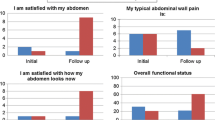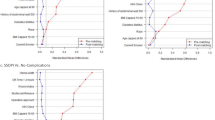Abstract
Background
The safety and effectiveness of expectant management (e.g., watchful waiting or initially managing non-operatively) for patients with a ventral hernia is unknown. We report our 3-year results of a prospective cohort of patients with ventral hernias who underwent expectant management.
Methods
A hernia clinic at an academic safety-net hospital was used to recruit patients. Any patient undergoing expectant management with symptoms and high-risk comorbidities, as determined by a surgeon based on institutional criteria, would be included in the study. Patients unlikely to complete follow-up assessments were excluded from the study. Patient-reported outcomes were collected by phone and mailed surveys. A modified activities assessment scale normalized to a 1–100 scale was used to measure results. The rate of operative repair was the primary outcome, while secondary outcomes include rate of emergency room (ER) visits and both emergent and elective hernia repairs.
Results
Among 128 patients initially enrolled, 84 (65.6%) completed the follow-up at a median (interquartile range) of 34.1 (31, 36.2) months. Overall, 28 (33.3%) patients visited the ER at least once because of their hernia and 31 (36.9%) patients underwent operative management. Seven patients (8.3%) required emergent operative repair. There was no significant change in quality of life for those managed non-operatively; however, substantial improvements in quality of life were observed for patients who underwent operative management.
Conclusions
Expectant management is an effective strategy for patients with ventral hernias and significant comorbid medical conditions. Since the short-term risk of needing emergency hernia repair is moderate, there could be a safe period of time for preoperative optimization and risk-reduction for patients deemed high risk.

Similar content being viewed by others
References
Fekkes JF, Velanovich V (2015) Amelioration of the effects of obesity on short-term postoperative complications of laparoscopic and open ventral hernia repair. Surg Laparosc Endosc Percutan Tech 25(2):151–157
Ching SS, Sarela AI, Dexter SP, Hayden JD, McMahon MJ (2008) Comparison of early outcomes for laparoscopic ventral hernia repair between nonobese and morbidly obese patient populations. Surg Endosc 22(10):2244–2250
Sharma A, Mehrotra M, Khullar R, Soni V, Baijal M, Chowbey PK (2011) Laparoscopic ventral/incisional hernia repair: a single centre experience of 1,242 patients over a period of 13 years. Hernia 15(2):131–139
Tsereteli Z, Pryor BA, Heniford BT, Park A, Voeller G, Ramshaw BJ (2008) Laparoscopic ventral hernia repair (LVHR) in morbidly obese patients. Hernia 12(3):233–238
Le D, Deveney CW, Reaven NL, Funk SE, McGaughey KJ, Martindale RG (2013) Mesh choice in ventral hernia repair: so many choices, so little time. Am J Surg 205(5):602–607
Fischer JP, Basta MN, Wink JD, Wes AM, Kovach SJ (2014) Optimizing patient selection in ventral hernia repair with concurrent panniculectomy: an analysis of 1974 patients from the ACS-NSQIP datasets. J Plast Reconstr Aesthet Surg 67(11):1532–1540
Berger RL, Li LT, Hicks SC, Davila JA, Kao LS, Liang MK (2013) Development and validation of a risk-stratification score for surgical site occurrence and surgical site infection after open ventral hernia repair. J Am Coll Surg 217(6):974–982
Goodenough CJ, Ko TC, Kao LS et al (2015) Development and validation of a risk stratification score for ventral incisional hernia after abdominal surgery: hernia expectation rates in intra-abdominal surgery (the HERNIA Project). J Am Coll Surg 220(4):405–413
Kaoutzanis C, Leichtle SW, Mouawad NJ et al (2015) Risk factors for postoperative wound infections and prolonged hospitalization after ventral/incisional hernia repair. Hernia 19(1):113–123
Finan KR, Vick CC, Kiefe CI, Neumayer L, Hawn MT (2005) Predictors of wound infection in ventral hernia repair. Am J Surg 190(5):676–681
Stey AM, Russell MM, Sugar CA et al (2015) Extending the value of the national surgical quality improvement program claims dataset to study long-term outcomes: rate of repeat ventral hernia repair. Surgery 157(6):1157–1165
Nelson JA, Fischer J, Chung CC et al (2015) Readmission following ventral hernia repair: a model derived from the ACS-NSQIP datasets. Hernia 19(1):125–133
Lovecchio F, Farmer R, Souza J, Khavanin N, Dumanian GA, Kim JY (2014) Risk factors for 30-day readmission in patients undergoing ventral hernia repair. Surgery 155(4):702–710
Koolen PG, Ibrahim AM, Kim K et al (2014) Patient selection optimization following combined abdominal procedures: analysis of 4925 patients undergoing panniculectomy/abdominoplasty with or without concurrent hernia repair. Plast Reconstr Surg 134(4):539e–550e
Fitzgibbons RJ Jr, Ramanan B, Arya S et al (2013) Long-term results of a randomized controlled trial of a nonoperative strategy (watchful waiting) for men with minimally symptomatic inguinal hernias. Ann Surg 258(3):508–515
O’Dwyer PJ, Norrie J, Alani A, Walker A, Duffy F, Horgan P (2006) Observation or operation for patients with an asymptomatic inguinal hernia: a randomized clinical trial. Ann Surg 244(2):167–173
Eid GM, Wikiel KJ, Entabi F, Saleem M (2013) Ventral hernias in morbidly obese patients: a suggested algorithm for operative repair. Obes Surg 23(5):703–709
Cevese PG, D’Amico DF, Biasiato R et al (1984) Peristomal hernia following end-colostomy: a conservative approach. Ital J Surg Sci 14(3):207–209
Cherney DZ, Siccion Z, Chu M, Bargman JM (2004) Natural history and outcome of incarcerated abdominal hernias in peritoneal dialysis patients. Adv Perit Dial 20:86–89
Liu NW, Hackney JT, Gellhaus PT et al (2014) Incidence and risk factors of parastomal hernia in patients undergoing radical cystectomy and ileal conduit diversion. J Urol 191(5):1313–1318
Verhelst J, Timmermans L, van de Velde M et al (2015) Watchful waiting in incisional hernia: Is it safe? Surgery 157(2):297–303
Kokotovic D, Sjolander H, Gogenur I, Helgstrand F (2016) Watchful waiting as a treatment strategy for patients with a ventral hernia appears to be safe. Hernia 20(2):281–287
Liang MK, Holihan JL, Itani K et al (2017) Ventral Hernia management: expert consensus guided by systematic review. Ann Surg 265(1):80–89
Holihan JL, Alawadi ZM, Harris JW et al (2016) Ventral hernia: patient selection, treatment, and management. Curr Probl Surg 53(7):307–354
Muysoms FE, Miserez M, Berrevoet F et al (2009) Classification of primary and incisional abdominal wall hernias. Hernia 13(4):407–414
Krpata DM, Schmotzer BJ, Flocke S et al (2012) Design and initial implementation of HerQLes: a hernia-related quality-of-life survey to assess abdominal wall function. J Am Coll Surg 215(5):635–642
McCarthy M Jr, Jonasson O, Chang CH et al (2005) Assessment of patient functional status after surgery. J Am Coll Surg 201(2):171–178
Cherla DV, Moses ML, Viso CP et al (2018) Impact of abdominal wall hernias and repair on patient quality of life. World J Surg 42(1):19–25. https://doi.org/10.1007/s00268-017-4173-6
Fitzgibbons RJ, Jonasson O, Gibbs J et al (2003) The development of a clinical trial to determine if watchful waiting is an acceptable alternative to routine herniorrhaphy for patients with minimal or no hernia symptoms. J Am Coll Surg 196(5):737–742
Sarosi GA, Wei Y, Gibbs JO et al (2011) A clinician’s guide to patient selection for watchful waiting management of inguinal hernia. Ann Surg 253(3):605–610
Funding
No external funding was used to perform this study.
Author information
Authors and Affiliations
Corresponding author
Ethics declarations
Conflict of interest
The authors declare that they no conflicts of interest.
Additional information
Publisher's Note
Springer Nature remains neutral with regard to jurisdictional claims in published maps and institutional affiliations.
Electronic supplementary material
Below is the link to the electronic supplementary material.
Rights and permissions
About this article
Cite this article
Martin, A.C., Lyons, N.B., Bernardi, K. et al. Expectant Management of Patients with Ventral Hernias: 3 Years of Follow-up. World J Surg 44, 2572–2579 (2020). https://doi.org/10.1007/s00268-020-05505-2
Published:
Issue Date:
DOI: https://doi.org/10.1007/s00268-020-05505-2




